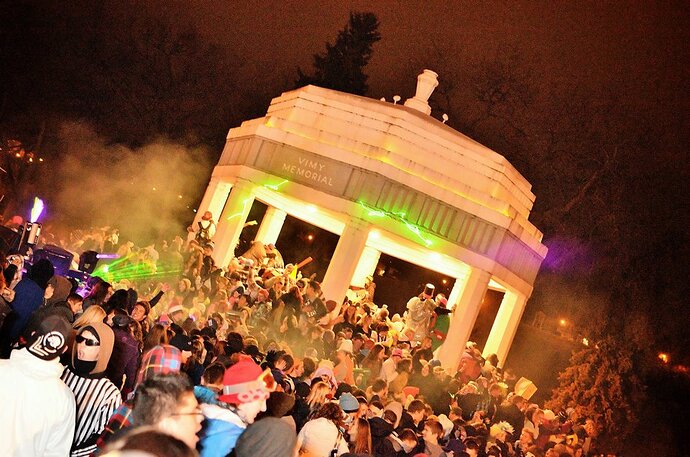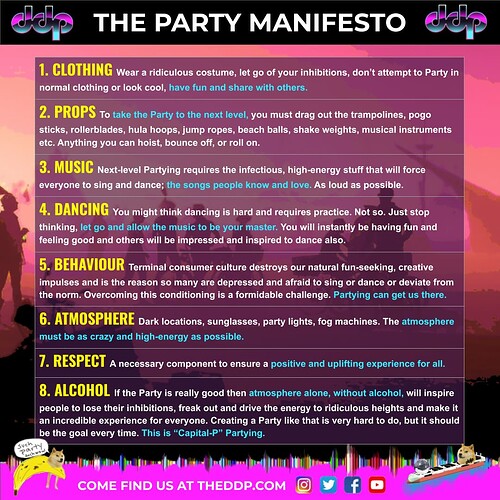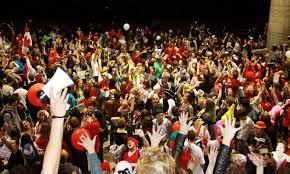Societal Issues Targeted
- Breaking down social barriers between strangers
- Challenging the norm of isolation in public spaces
- Creating spontaneous moments of shared joy and connection
- Building confidence through collective action
“When we dance together, we remember that we’re all human”
― Gary Lachance, The Decentralized Dance Party
Intro
Imagine suddenly stumbling across a joyous dance party while you’re doing something mundane and boring, like on your way to work, or out grocery shopping – when you bump into a party full of cheerful welcoming people dressed in fabulous costumes and inviting you to come party with them.
Public Dance Parties transform ordinary spaces into celebrations of human connection, breaking down the invisible walls we build between strangers. This activity creates moments of pure joy that remind us how simple it can be to connect with others.
Notable Public Dance Leaders
The Decentralized Dance Party (DDP)
Gary Lachance, founder of the DDP, shares his powerful vision:
“The only thing I fear is leading a life that perpetuates the status quo. I’m afraid to contribute to a culture where permits are required to make any sort of movement or sound or have any unconventional good times. We enjoy a right to peacefully assemble in our public spaces and it should be exercised whenever possible.”
“I fear for the future of a sterilized society that has forgotten how to have fun; a culture where everyone is afraid to express themselves and much of the populace relies on antidepressants to make it through the day.”
“That’s why I have devoted my life to confronting it all head-on via the craziest creative endeavours I can concoct. I do my best to inspire deviation from the norm and steer things in directions I believe are positive and exciting. That’s what quality art is all about”
The Liberators International
Peter Sharp and The Liberators International have shown how a single brave dancer can start a movement that transforms an entire space, bringing joy and connection to hundreds of strangers.
Jacques - The Party Scientist
https://www.youtube.com/watch?v=MD0PVVzRPE0)
Jacques brings the party and demonstrates how scientific understanding of music, movement, and human psychology can be applied to create the perfect conditions for spontaneous celebration.
How To
- Choose your meeting location (train stations, parks, and city squares work great) and plan a route.
- Plan a few rally-points in open public spaces so anyone running late can try to catch up, and people can go for toilet/water breaks
- Bring big portable speakers (or coordinate multiple speakers for bigger areas) via radio transmitters (see the DDP website) or bluetooth repeaters
- Create an upbeat playlist with lots of well-known songs people can’t resist dancing too. Don’t be afraid to get cheesy, a throw back to the Spice Girls, or the Ricky theme tune always goes down well.
- Its best to start with a small team if you can, although I’ve run them solo, having a few confident dancers to break the ice is a great way to get people to join in
- Assign some trusted attendees to keep an eye on the flow of the activity and step in to hype areas where its dropping off with some funk-tastic dance moves, a game, a sing along, a dance circle, or leading everyone through a dance together.
Pro-Tips
- Start with popular, universally known songs that make people want to move
- Bring extra props (bubbles, silly hats, light-up accessories) to share
- Create a simple dance move others can easily copy
- Have “dance ambassadors” ready to invite hesitant onlookers
- Consider a silent disco version for noise-sensitive areas
Benefits
Public dance creates what sociologists call “collective effervescence” - a shared emotional experience that bonds people together. When we dance in public, we:
- Break down social barriers
- Create lasting memories
- Build community confidence
- Challenge social anxiety
- Generate spontaneous joy
- Show others it’s okay to express themselves
Legal Stuff
- Keep emergency exits clear and don’t block busy walkways
- Be prepared to interact positively with local authorities




